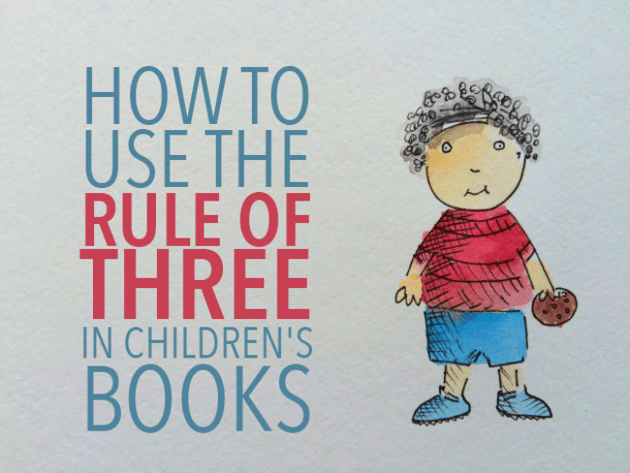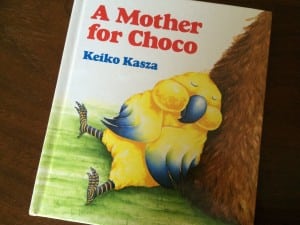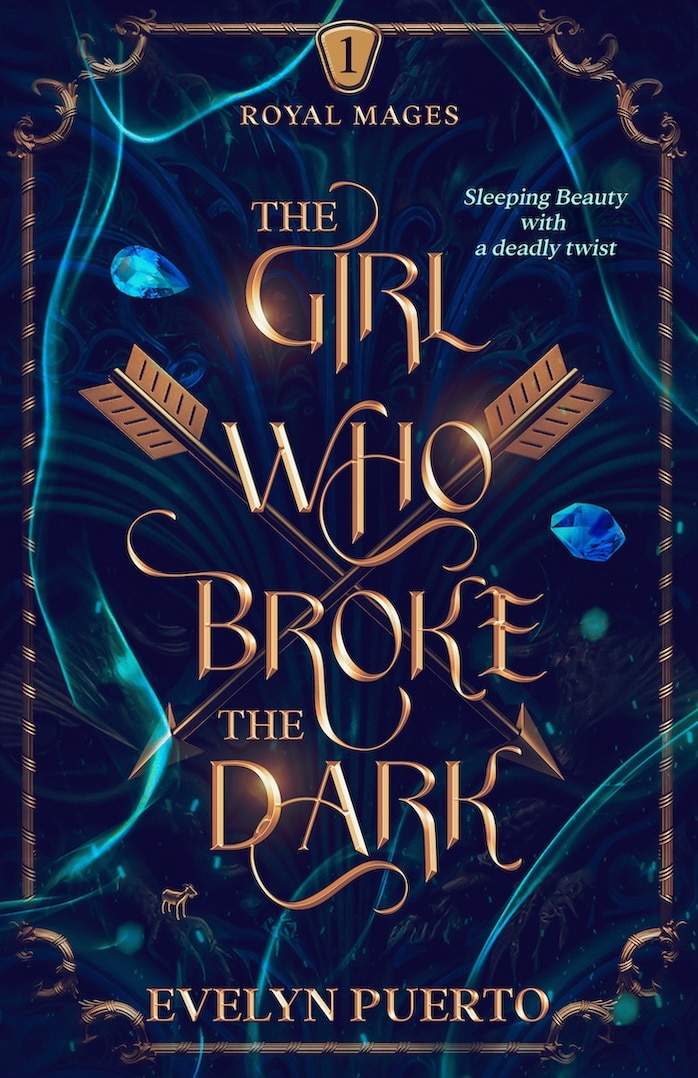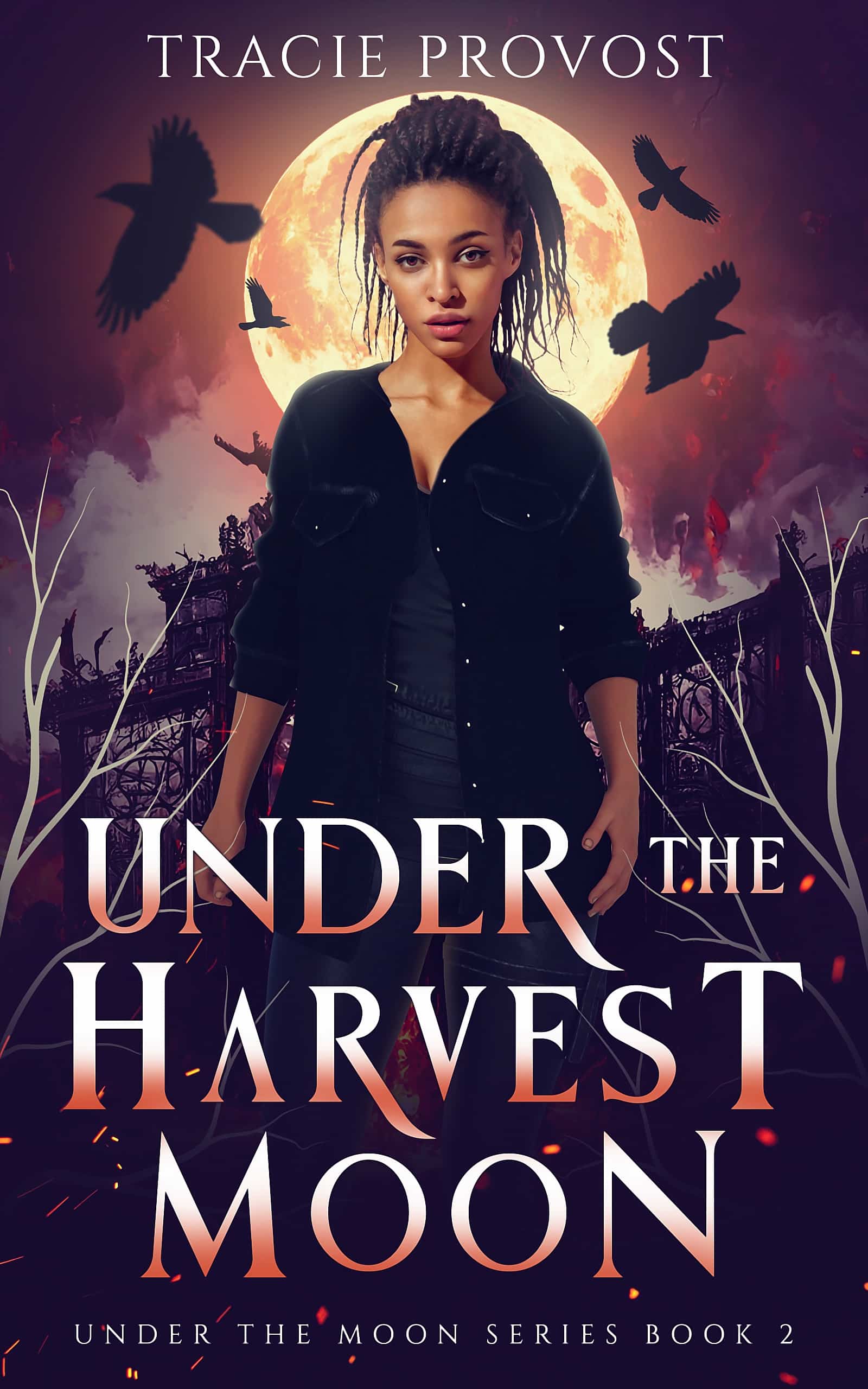Interesting things come in threes. There are three little pigs, not four. Three kittens lost their mittens, Goldilocks and the three bears, three musketeers. You might even say “three is a magic number.”
If you're a writer, especially a children's book author, you should be using the rule of three in your writing. In this post, we'll talk about how.

Once upon a time there was a little boy, Frank, who wanted to eat a cookie. His mother said, “Frank, you cannot have a cookie before lunch.”
For today's practice, let's help Frank get his cookie using the rule of three.
What Is the Rule of Three?
The rule of three is a common storytelling device and rhetorical technique. As a storytelling device, you find it most often in fairy tales, myths, and fables, but it's common in all forms of literature, poetry, and songwriting.
Here's what Wikipedia says about the rule of three:
The rule of three… suggests that things that come in threes are inherently funnier, more satisfying, or more effective than other numbers of things.
How does this work practically though?
In our story about Frank and his cookie, Frank has a problem. In classic children's book format, he will try three times to solve his problem.
On the fourth attempt Frank will finally solve his cookie dilemma.
Why the Rule of Three Helps Create an Engaging Story
Before you say, “Hey, Hodges, I read a children's book once, and they tried four times, or five times, to solve a problem.” I know, I know.
Whenever there is a general rule, someone will deviate from it. The rule of three is a guideline.
If the character with a problem, the protagonist, solves the problem after one attempt, the story would be rather boring, wouldn't it? Readers want to see conflict, struggle!
Your readers want your protagonist to have to overcome the problem with repeating attempts. Why? Because readers want to identify with someone overcoming a major event, in other words something that is hard, even if it is only to get a cookie out of the pantry when they are not supposed to have any.
Three is a magic number. Yes it is; it’s a magic number. Somewhere in the ancient, mystic trinity you get three as a magic number. —Bob Dorough, School House Rocks
Two makes the set up, and the third closes the triangle.
Example of the Rule of Three: A Mother for Choco

A Mother for Choco by Keiko Kasza is a perfect example of the rule of three.
Choco, like all protagonists, has a problem. He doesn't know who his mother is. So what does he do? He sets out to find her.
He meets three different animals, a giraffe, a penguin, and a walrus. He asks each of the three in turn if they are his mother; they all say no.
It isn't until his his fourth attempt he finds his mother. I won't tell you who it is, as that would give away the story.
Okay, let's help Frank get his cookie. Here is the plot outline for Frank Wants a Cookie to show you what I mean. (I just met Frank today as I wrote this post.)
How To Use the Rule of Three to Help Frank Get His Cookie
Frank wants a cookie. His mother said he is not allowed to eat any cookies before lunch.
Frank is going to make three attempts to get the cookie from the kitchen. He will get the cookie on the fourth attempt.
Failed Attempt#1. Frank goes in the kitchen, and gets a glass of water. While the water is running, he turns on the trash compactor to hide the noise of the cookie jar. Then he sneaks over to the cookie jar and takes out a cookie. His mother walks in and says, “Frank, no cookies before lunch.” She takes the cookie away from Frank.
Failed Attempt #2. Frank lets the dog out of the backyard. Then runs into his mother's painting studio. “Mom, the puppy is loose,” he says. “Please go and find her.” As his mother runs out the front door, he runs into the kitchen and takes out a cookie and stuffs it in his pocket.” His mother runs back in the house with the puppy. The puppy sniffs Franks pocket. Then his mother takes the cookie out of his pocket and puts it back in the cookie jar.
Failed Attempt #3. In an attempt to get his mother to leave the house, Frank calls his mother's cell phone from the house phone, covers his mouth with a handkerchief and says in a deep voice, “Hello, Mrs. Smith, the rosebush you ordered has arrived at the nursery.” The mother notices the telephone number, smiles, and says, “Oh, thank you. I will be right there to pick it up.” She hangs up the phone, goes and gets her son and says, “Come on Frank, the nursery just called. Let's go and pick up the rosebush I ordered.” Frank goes with his mother to the plant store. He doesn't get a cookie.
Success! Frank picks flowers from his mother's garden, goes to the front door, rings the door bell, and asks his mother if she would like to buy flowers. He holds a sign, “Flowers! Cost: one cookie and one hug.” His mother smiles, looks at her watch, and says, “Well, it is lunch time. And I do love flowers.” She goes into the kitchen, gets a cookie, hands it to her son as he gives her the flowers. Then they hug. Frank eats his cookie.
Why the Rule of Three Makes Us Care About Frank’s Story
Every story is about a character who wants something and is willing to go through conflict to get it.
In the story we worked on above, Frank wants a cookie. He wants it so much that he tried three times to get that cookie, each time failing.
The important thing for writers to remember though is that each time he failed we grew to like him a little more. We became a little more engaged in the story. If he had just gotten the cookie on the first try, we wouldn’t have cared nearly as much.
The fourth time, Frank succeeded. And as readers, we're cheering him on. In fact, after going through each of the failed attempts, it feels a little like we finally succeed.
The same is true for your stories, whether you’re writing children’s books or not. If you let your protagonist get what he or she wants the first time, you'll lose your readers.
However, if you let your protagonist try and fail using the rule of three, they won't be able to stop reading.
What do you think of the rule of three? Please tell me in the comments.
PRACTICE
For practice today, please think of another way Frank could have tried to get a cookie. Write for fifteen minutes.
Or think of another character, and think of three ways they will try to solve a problem. I hate being told what to do. So, today, I am giving you a choice. Help Frank get his cookie, or create your own character, give them a problem, and help them solve it.
When your time is up, post your practice in the Pro Practice Workshop. And if you post, please be sure to give feedback to your fellow writers.
Pamela writes stories about art and creativity to help you become the artist you were meant to be. She would love to meet you at www.ipaintiwrite.com.



Writing a mystery with three failed attempts at a solution. Great example for the practice of using the rule of three. Thanks.
Hello Maria,
Yes, this would work well in a mystery story. The failed attempts will help us love your character more. We will want them to win.
xo
Pamela
What do I think of the rule of three? I’m intrigued. It seems so obvious, but I’ve never considered it. Nor have I heard anyone else talk about it as a writing too. Maybe I need to “get out” more!
Thank you so much for the information and for the example.
Hello Carrie Lynn Lewis,
Usually the talk of the rule of three is about three pigs, or three examples to prove a point, but, I have noticed it in children’s books as well. Maybe I need to read more books than picture books!
You are very welcome. I hope you are having a wonderful day.
xo
Pamela
Pamela,
And maybe I need to read more picture books!
I had never thought of it that way. Now I won’t think of it any other way. Asa guideline it is as already said simple but magical.
If I were Frank I would just eat my lunch! (Charise -13) I would eat lunch early! (Israel-11)
Charise also said if she were the mom she would not have rewarded him, but she would throw the cookies in the trash…or in the river. Lol;)
Okay I’m going to do some writing now– this is awesome!
ps>they are now both asking for a popsicle…they were eating their lunch as we read so I guess I shall say YES ;D
Hello Valorie McDonald,
Thank you for reading the article to your children.
Your children are very smart. Did they ask for three popsicles? Charise didn’t want to reward him. I wonder if mothers would not want to buy a book where the child got the cookie before the sandwich?
Now, I want a popsicle.
xo
Pamela
This is Awesome, Pamela. I’m having a difficult time trying to come up with a plot for my contest story and WOW! You have just given me a wonderful idea. Three tries to get the cookie! Now, I beginning to know the plot to use for my contest story, but getting back to Frank, I will shortly post another way that Frank might have been able to get his cookie.
KEN
Hello Kenneth,
I am Martha, a dog. I take care of Mrs. Hodges. She is taking a nap now. I will tell her you liked her post.
Perhaps you need a dog in your story? Or three dogs. I am excited to read how you will help Frank get his cookie.
All my best,
xo
Martha
Another way that Frank might have used, though I’m still skeptical about this idea, he has a best friend name Corky who is about his age. They trade toys every once and a while. Tonka trucks, cars, trains. Now, Frank has something that Corky has been asking to trade with. A purple kite with the shape of a Boot that is rainbow colored. Frank has never wanted to trade this for anything. Frank contact Corky and plans to have him come over and ask his mother for a cookie, meet him outside and give the cookie to Frank. It works, Corky comes over and they play a little bit together for about 10 – 15 minutes. Corky smells the scent of chocolate baked Cookies. He’s about to leave. He asks Franks mother for a cookie before he dashes out the door. On his way around the backyard, out of the gate, he give the cookie to Frank and Frank then Trades his Kite. He takes a bite, but hears his mother’s voice calling him. He chews as much of the cookie as he can, swallows, rush to the sound of his mothers voice.
Hello again Kenneth,
Your idea is very solid. And it also shows how much Frank wants a cookie. True friends will always help you get a cookie, or, they will scratch behind your ears. But, perhaps, only dogs and cats like that.
I would like a cookie too, but I can’t eat chocolate.
Thank you for taking the time to write a story idea.
I will tell Mrs. Hodges your idea when she wakes up from her nap. Well, I will tell her after she takes me for a walk.
xo
Love Martha.
Martha, You have made my day. We, writers, can sometime be very, very, insecure. When we receive a thumbs up for something that we wrote, it almost makes us, especially me, believe that we are getting a smidget better. I wish that I can walk you! KEn
Painters (and children book illustrator’s) love three too. Three is important to the divine geometry found in nature. It has a natural rhythm – a sense of wholeness and balance. It’s also the angel number for the ascendant masters. I’ve been seeing streams of angel number for almost a year now beyond all chance since I started studying A Course in Miracles – so I love the number three. And not it’s just me. I was happy and relieved to hear Abraham say that angel numbers were Jerry Hick’s “favorite thing” and a sign of being more in alignment than not. <3
Hello Jenny Orelle,
Pamela is taking a nap. I am a dog who lives at Mrs. Hodges house. I take care of her.
How amazing to discover three in nature as well. Perhaps Mrs. Hodges should get another dog. There are only two in the house now.
Thank you for sharing your knowledge about the number three.
All my best,
xo
Love Martha
Another puppy would be fun and be sure to give her three kisses when she wakes up. ( ;
<3
Guess it also goes with that saying “the third time’s the charm!” And when you flip a coin your chances increase dramatically that you’re going to get a heads up if you haven’t yet!
Hello Rhonda White,
Yes, the third time’s the charm. I love that saying. I wish I could get three walks a day. I will have to tell Pamela what you said.
Wishing you lots of charm today.
xo
Love Martha
That was very helpful, I feel like I’ve now locked that technique away in my brain to use when I need it 🙂 Which if I want it to be can be very soon. Why limit myself?
Hello Mitch Hamilton,
I am so glad you found this article helpful. I will be sure to tell Pamela when she wakes up from her nap. I am a dog who helps her when she is sleeping.
I am very keen to know what you are going to write using the rule of three. I would like to be feed three times a day. And not just twice. I will have to have a talk with her when she wakes up.
xo
Love Martha
A while back I read how important it was to have your main character make failed attempts before they succeed. It caused me to take my children’s book, Emma’s Wish and to show that side of her. The side that truly was trying. And I found it strengthened my character and let the world see what I already knew was inside of her. Thanks for your creative way of conveying this.
As far as Frank, he even tried turning all the clocks to 1:00 in an effort to show his mom that lunch time had passed. If only he had remembered the clock on the microwave. Sigh.
Hello Anne Peterson,
Oh, how funny, the old change the clock trick. That would have worked if he hadn’t forgotten the microwave. How fun.
Emma had a wish? I would want Emma to get her wish too. And, if she had to try really hard, I would have been more drawn to her character. Very good choice Anne, to show that side of her.
I will tell Pamela you stopped by. She is still napping.
All my best,
xo
Love Martha, a dog
Ha Martha, I was reading ur comment & it wasn’t until the last piece “Love Martha, a dog” that broke a smile on my face! 🙂 Nice one mate 😉
I learned something new and very helpful. I wrote my own story about a little boy, Jack, who wanted to help feed the hungry. I had three scenarios in which his ways to make bigger donations got him to the best idea and in turn big success. This is just my second practice with Write Practice, but I am finally on the road and not just thinking about it. Thank you.
Hello Elaine Spielberg,
Jack sounds like a very kind and resourceful character. I will tell Pamela when she wakes up from her nap that her article helped you.
I am delighted to meet you.
Yes, just thinking about writing doesn’t really help if you don’t eventually write.
I wish you all my best,
xo
Love Martha, a dog
Frank was foiled again as his mom plopped the cookie out of his hand and sent him out to play before lunch. He was so hungry and the cookies smelled so good. He roamed around the back yard, first kicking his soccer ball and then bending down to look at a caterpillar crossing a rock. He didn’t want to play outside he wanted a cookie and when Frank wanted something he never gave up.
He walked around the yard and thought hard. Just as he was about to give up he spied his father’s fishing pole peeking through the garage window. That was it. He would catch a cookie. He took out the pole and crept quietly until he was right outside of the kitchen window. The cookie jar was right in front of the window. He cast the line like his father taught him and plunk it went right into the cookie jar on the first try. He slowly reeled it in and sure enough he had caught a big fat cookie. That was the best cookie he ever ate even if it did taste a little like trout.
Oh Marilyn Cullen-Reavill,
I love the cookie that tasted like trout! How fun. Thank you for helping Frank get a cookie.
You were very imaginative. And, now I want a cookie too. But, not one that tastes like trout.
Wishing you all my best,
Thank you for taking the time to help Frank.
xo
Pamela
Frank had an agreement with his mum. If he did the chores, he get the cookies. With much enthusiasm, he took his mighty Harry Potter wizard broom & swept the entire house within a magic flick. He took the garbage out like a strong muscle man. He took the dishes to the dishwasher.
Finally, finally, finally, the cookie moment had arrived. He was jumping all around the places with joy! Someone rang the door bell. It’s time for Frank to go to tuition classes. No more cookies for Frank!
I wrote my first draft with a variety of vocabs then I realised that this was supposed to be a children story so I amended it to easier grasping words. Not sure if I did it well on that though ha! Pls provide some helpful feedback on where could I improve thanks
Hello Alisa,
Thank you for trying to help Frank get his cookie. You were very imaginative giving him chores to do first. And how sad, he worked so hard, but wasn’t allowed to eat a cookie because he had to leave for his tuition class.
There are only very small areas where you would need to change the tense of words, from singular to plural. I may have missed a few. But these are the few I saw.
And never worry about missing a few grammar words, there are always editors or readers to help. Small details can be fixed, the big picture of creating worlds and characters and stories are where you get to be creative.
he get the cookies – he gets the cookies
within a magic flick – with a magic flick
all around the places with joy – all around the place with joy
tuition classes – tuition class
All my best,
xo
Pamela
Dear Bhaswati,
Your story is rich with details, and suspense.
You have shown me Aarwa’s character. How brave she is to go and buy candles for Taher. And you left we wanted to know more.
Will Taher come home for his birthday this year? Who are the rebels? Why did Taher leave?
And what is the main conflict? What obstacles does Aarwas have to overcome. What does she want?
Here are a few articles on the important of character and conflict in a story. I hope they are helpful.
Now I am so curious. Is there more to this story? I really want to know if she buys the candle.
https://thewritepractice.com/conflict-101/
https://thewritepractice.com/how-to-write-a-story-character/
All my best,
xo
Pamela
Hi, have just discovered the Write Practice. How refreshing to have something to practice writing about. Have probably spent far too long reading on what to do/not to do when writing instead of actually putting words down on paper. Thank you. Thought I’d be brave and post an idea about Frank and the cookie.
Frank asked his mum if he could grant her one wish what it would be. “Tidying your room would be helpful”. Frank dashed upstairs, frantically stuffed his clothes into half opened draws and rammed his toys into the toy box. Thundering downstairs he announced “All done!” with an immediate request for a cookie. “No Frank” said Mum.
Frank sat on the sofa pretending to read his comic. After a short while he casually sauntered over to his mum and pecked her on the cheek. “Thank you Frank”. “Can I have a cookie now?” he asked. “No Frank”.
Frank disappeared up to his room and began writing a letter. “Dear Mum, I love you. Can I have a cookie please?” He felt pretty pleased with himself. He had used his best handwriting ever, not something Frank found easy by any means. He crept downstairs, slipped the letter under the door and waited.
Time seemed to stand still, seconds felt like minutes. Mum opened the door and beckoned Frank to come in and sit down next to her. “Just because I didn’t let you have a cookie doesn’t mean I don’t love you Frank, in fact I love you very much, with all my heart”. “Well Grandma says, once a wish, twice a kiss, three sometimes a letter, four for something better. I thought if I did all those things you’d let me have a cookie”.
Mum burst out laughing and gathered Frank in the biggest of bear hugs. A deal was struck, sandwich first then a cookie. While Frank relished his cookie and took comfort in the warmth of his mother’s love, he listened intently as she recited the sneezing
rhyme from start to finish.
I really like the idea of the Rule of Three when writing. It gave me a purpose when thinking what to write about and adds intrigue as to how a tale might end. In photography the rule of thirds is something to remember and displaying things in a group of three is supposed to be more attractive to the eye, so there obviously is something magical about the number 3!
Umm, i think i’m very late to discover this amazing articel.. But.. just please let me try to help Frank gets his cookies 😀
After baking with his Mom, he offers his self to deliver the cookies to their neighbor. When he deliver these cookies to the neighbor, he ask them for the cookies. “Let me try it? My mom is not allowing me to eat the cookies before lunch :(” And surprisingly, his mom show up in neighbor’s cell phone. “Dont even try it before lunch, Frankie”.
Frank runs to his room and took a piece of paper, then he hurry run to his mother “Mom, look! A got A for my math test last week!” “good job! Frankie” “Can i ask for the cookies?” “Of course Frank, after lunch”.
Frank is following his mother everywhere she goes. “Mom, my teacher tell me that we have to share with people”. “Your teacher is right, Frank”. “Can you share the cookies with me, Mom?” His mom smile “Yes Frank, I do love sharing. After lunch”
Finally Frank is giving up with his mother. He sits in dining room and wait patiently. He watch the clock “Tik tok tik tok”. His mom smile looking Frank waiting patiently. “Moooommm! This is lunch timeee where is my cookiees?” Mother gives him cookies and thank to him “Thanks for waiting patiently, Frank. You’re a good boy”
I’m sorry for the bad grammer, it’s my first time 🙂